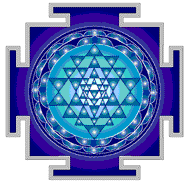Vigyan Bhairav Tantra 13
From Bluetruth
13. Or, imagine the five-colored circles of the peacock tail to be your five senses in illimitable space. Now let their beauty melt within. Similarly, at any point in space or on a wall -- until the point dissolves. Then your wish for another comes true.
All these sutras are concerned with how to achieve the inner center. The basic mechanism used, the basic technique used is, if you can create a center outside -- anywhere: in the mind, in the heart, or even outside on a wall -- and if you concentrate totally on it and you bracket out the whole world, you forget the whole world and only one point remains in your consciousness, suddenly you will be thrown to your inner center. How does it work? First understand this... Your mind is just a vagabond, a wandering. It is never at one point. It is always going, moving, reaching, but never at any point. It goes from one thought to another, from A to B. But it is never at the A; it is never at the B. It is always on the move. Remember this: mind is always on the move, hoping to reach somewhere but never reaching. It cannot reach! The very structure of the mind is movement. It can only move; that is the inherent nature of the mind. The very process is movement -- from A to B, from B to C... it goes on and on. If you stop at A or B or any point, the mind will fight with you. The mind will say, "Move on," because if you stop the mind dies immediately. It can be alive only in movement.
The mind means a process. If you stop and do not move, mind suddenly becomes dead, it is no more there; only consciousness remains. Consciousness is your nature; mind is your activity -- just like walking. It is difficult because we think mind is something substantial. We think mind is a substance -- it is not, mind is just an activity. So it is really better to call it "minding" than mind. It is a process just like walking. Walking is a process, if you stop, there is no walking. You have legs, but no walking. Legs can walk, but if you stop then legs will be there but there will be no walking. Consciousness is like legs -- your nature. Mind is like walking -- just a process. When consciousness moves from one place to another, this process is mind. When consciousness moves from A to B, from B to C, this movement is mind. If you stop the movement, there is no mind. You are conscious, but there is no mind. You have legs, but no walking. Walking is a function, an activity; mind is also a function, an activity. If you stop at any point, the mind will struggle. The mind will say, "Go on!" The mind will try in every way to push you forward or backward or anywhere -- but, "Go on!" Anywhere will do, but do not stay at one point.
If you insist and if you do not obey the mind... it is difficult because you have always obeyed. You have never ordered the mind; you have never been masters. You cannot be because, really, you have never disidentified yourself from the mind. You think you are the mind. This fallacy that you are the mind gives the mind total freedom, because then there is no one to master it, to control it. There is no one! Mind itself becomes the master. It may become the master, but that mastery is just seemingly so. Try once and you can break that mastery -- it is false. Mind is just a slave pretending to be the master, but it has pretended so long, for lives and lives, that even the master believes that the slave is the master. That is just a belief. Try the contrary and you will know that that belief was totally unfounded. This first sutra says, imagine the five-colored circles of the peacock tail to be your five senses in illimitable space. Now let their beauty melt within. Think that your five senses are five colors, and those five colors are filling the whole space. Just imagine your five senses are five colors -- beautiful colors, alive, extended into infinite space. Then move within with those colors.
Move within and feel a center where all these five colors are meeting within you. This is just imagination, but it helps. Just imagine these five colors penetrating within you and meeting at a point. Of course, these five colors will meet at a point: the whole world will dissolve. In your imagination there are only five colors -- just like around the tail of a peacock -- spread all over space, going deep within you, meeting at a point. Any point will do, but the hara is the best. Think that they are meeting at your navel -- that the whole world has become colors, and those colors are meeting at your navel. See that point, concentrate on that point, and concentrate until the point dissolves. If you concentrate on the point it dissolves, because it is just imagination. Remember, whatsoever we have done is imagination. If you concentrate on it, it will dissolve. And when the point dissolves, you are thrown to your center. The world has dissolved. There is no world for you. In this meditation there is only color. You have forgotten the whole world; you have forgotten all the objects. You have chosen only five colors. Choose any five colors. This is particularly for those who have a very keen eye, a very deep color sensitivity.
This meditation will not be helpful to everyone. Unless you have a painter's eye, a color consciousness, unless you can imagine color, it is difficult. Have you ever observed that your dreams are colorless? Only one person in a hundred is capable of seeing colored dreams. You see just black and white. Why? The whole world is colored and your dreams are colorless. If one of you remembers that his dreams are colored, this meditation is for him. If someone remembers even sometimes that he sees colors in his dreams, then this meditation will be for him. If you say to a person who is insensitive to color, "Imagine the whole space filled with colors," he will not be able to imagine. Even if he tries to imagine, if he thinks, "Red," he will see the word `red', he will not see the color. He will say, "Green," and the word `green' will be there, but there will be no greenness. So if you have a color sensitivity, then try this method. There are five colors. The whole world is just colors and those five colors are meeting in you. Deep down somewhere in you, those five colors are meeting. Concentrate on that point, and go on concentrating on it. Do not move from it; remain at it. Do not allow the mind. Do not try to think about green and red and yellow and about colors -- do not think. Just see them meeting in you. Do not think about them! If you think, the mind has moved. Just be filled with colors meeting in you, and then at the meeting point, concentrate. Do not think! Concentration is not thinking; it is not contemplation.
If you are really filled with colors and you have become just a rainbow, a peacock, and the whole space is filled with colors, it will give you a deep feeling of beauty. But do not think about it; do not say it is beautiful. Do not move in thinking. Concentrate on the point where all these colors are meeting and go on concentrating on it. It will disappear, it will dissolve, because it is just imagination. And if you force concentration, imagination cannot remain there, it will dissolve. The world has dissolved already; there were only colors. Those colors were your imagination. Those imaginative colors were meeting at a point. That point, of course, was imaginary -- and now, with deep concentration, that point will dissolve. Where are you now? Where will you be? You will be thrown to your center. Objects have dissolved through imagination. Now imagination will dissolve through concentration. You alone are left as a subjectivity. The objective world has dissolved; the mental world has dissolved. You are there only as pure consciousness. That is why this sutra says: At any point in space or on a wall... This will help. If you cannot imagine colors, then any point on the wall will help. Take anything just as an object of concentration.
If it is inner it is better, but again, there are two types of personalities. For those who are introvert, it will be easy to conceive of all the colors meeting within. But there are extroverts who cannot conceive of anything within. They can imagine only the outside. Their minds move only on the outside; they cannot move in. For them there is nothing like innerness. The English philosopher David Hume has said, "Whenever I go in, I never meet any self. All that I meet are only reflections of the outside world -- a thought, some emotion, some feeling. I never meet the innerness, I only meet the outside world reflected in." This is the extrovert mind par excellence, and David Hume is one of the most extrovert minds. So if you cannot feel anything within, and if the mind asks, "What does this innerness mean? How to go in?" then try any point on the wall instead. There are persons who come to me and ask how to go in. It is a problem, because if you know only outgoing-ness, if you know only outward movements, it is difficult to imagine how to go in. If you are an extrovert then do not try this point inside, try it outside. The same will be the result. Make a dot on the wall; concentrate on it. Then you will have to concentrate on it with open eyes.
If you are creating a center inside, a point within, then you will have to concentrate with closed eyes. Make a point on a wall and concentrate on it. The real thing happens because of concentration, not because of the point. Whether it is out or in is irrelevant. It depends on you. If you are looking at the outside wall, concentrating on it, then go on concentrating until the point dissolves. That has to be noted: until the point dissolves Do not blink your eyes, because blinking gives a space for the mind to move again. Do not blink, because then the mind starts thinking. It becomes a gap; in the blinking, the concentration is lost. So no blinking. You might have heard about Bodhidharma, one of the greatest masters of meditation in the whole history of humankind. A very beautiful story is reported about him. He was concentrating on something -- something outward. His eyes would blink and the concentration would be lost, so he tore off his eyelids. This is a beautiful story: he tore off his eyelids, threw them away, and concentrated. After a few weeks, he saw some plants growing on the spot where he had thrown his eyelids. This anecdote happened on a mountain in China, and the mountain's name is Tah, or Ta. Hence, the name `tea'. Those plants which were growing became tea, and that is why tea helps you to be awake. When your eyes are blinking and you are falling down into sleep, take a cup of tea. Those are Bodhidharma's eyelids. That is why Zen monks consider tea to be sacred.
Tea is not any ordinary thing, it is sacred -- Bodhidharma's eyelids. In Japan they have tea ceremonies, and every house has a tea room, and the tea is served with religious ceremony; it is sacred. Tea has to be taken in a very meditative mood. Japan has created beautiful ceremonies around tea drinking. They will enter the tea room as if they are entering a temple. Then the tea will be made, and everyone will sit silently listening to the samovar bubbling. There is the steam, the noise, and everyone just listening. It is no ordinary thing... Bodhidharma's eyelids. And because Bodhidharma was trying to be awake with open eyes, tea helps. Because the story happened on the mountain of Tah, it is called tea. Whether true or untrue, this anecdote is beautiful. If you are concentrating outwardly, then non-blinking eyes will be needed, as if you no longer have eyelids. That is the meaning of throwing away the eyelids. You have only eyes, without eyelids to close them. Concentrating until the point dissolves. If you persist, if you insist and do not allow the mind to move, the point dissolves. And when the point dissolves, if you were concentrated on the point and there was only this point for you in the world, if the whole world had dissolved already, if only this point remained and now the point also dissolves, then the consciousness cannot move anywhere.
There is no object to move to -- all the dimensions are closed. The mind is thrown to itself, the consciousness is thrown to itself, and you enter the center. So whether in or out, within or without, concentrate until the point dissolves. This point will dissolve for two reasons. If it is within, it is imaginary -- it will dissolve. If it is outside, it is not imaginary, it is real. You have made a dot on the wall and have concentrated on it. Then why will this dot dissolve? One can understand it dissolving inside -- it was not there at all; you just imagined it -- but on the wall it is there, so why will it dissolve? It dissolves for a certain reason. If you concentrate on a point, the point is not really going to dissolve, the mind dissolves. If you are concentrating on an outer point, the mind cannot move. Without movement it cannot live, it dies, it stops. And when the mind stops you cannot be related with anything outward. Suddenly all bridges are broken, because mind is the bridge. When you are concentrating on a point on the wall, constantly your mind is jumping from you to the point, from the point to you, from you to the point. There is a constant jumping; there is a process. When the mind dissolves you cannot see the point, because really, you never see the point through the eyes: you see the point through the mind AND through the eyes. If the mind is not there, the eyes cannot function.
You may go on staring at the wall, but the point will not be seen. The mind is not there; the bridge is broken. The point is real -- it is there. When the mind will come back, you will see it again; it is there. But now you cannot see it. And when you cannot see, you cannot move out. Suddenly, you are at your center. This centering will make you aware of your existential roots. You will know from where you are joined to the existence. In you, there is a point which is related with the total existence, which is one with it. Once you know this center, you know you are at home. This world is not alien. You are not an outsider. You are an insider, you belong to the world. There is no need of any struggle, there is no fight. There is no inimical relationship between you and the existence. The existence becomes your mother. It is the existence that has come into you and that has become aware. It is the existence that has flowered in you. This feeling, this realization, this happening... and there can be no anguish again. Then bliss is not a phenomenon; it is not something that happens and then goes. Then blissfulness is your very nature.
When one is rooted in one's center, blissfulness is natural. One happens to be blissful, and by and by one even becomes unaware that one is blissful, because awareness needs contrast. If you are miserable, then you can feel it when you are blissful. When misery is no more, by and by you forget misery completely. And you forget your bliss also. And only when you can forget your bliss also are you really blissful. Then it is natural. As stars are shining, as rivers are flowing, so are you blissful. Your very being is blissful. It is not something that has happened to you: now it IS YOU.
With the second sutra, the mechanism is the same, the scientific basis is the same, the working structure is the same:
- Vigyan Bhairav Tantra 14You need JavaScript enabled for viewing comments





